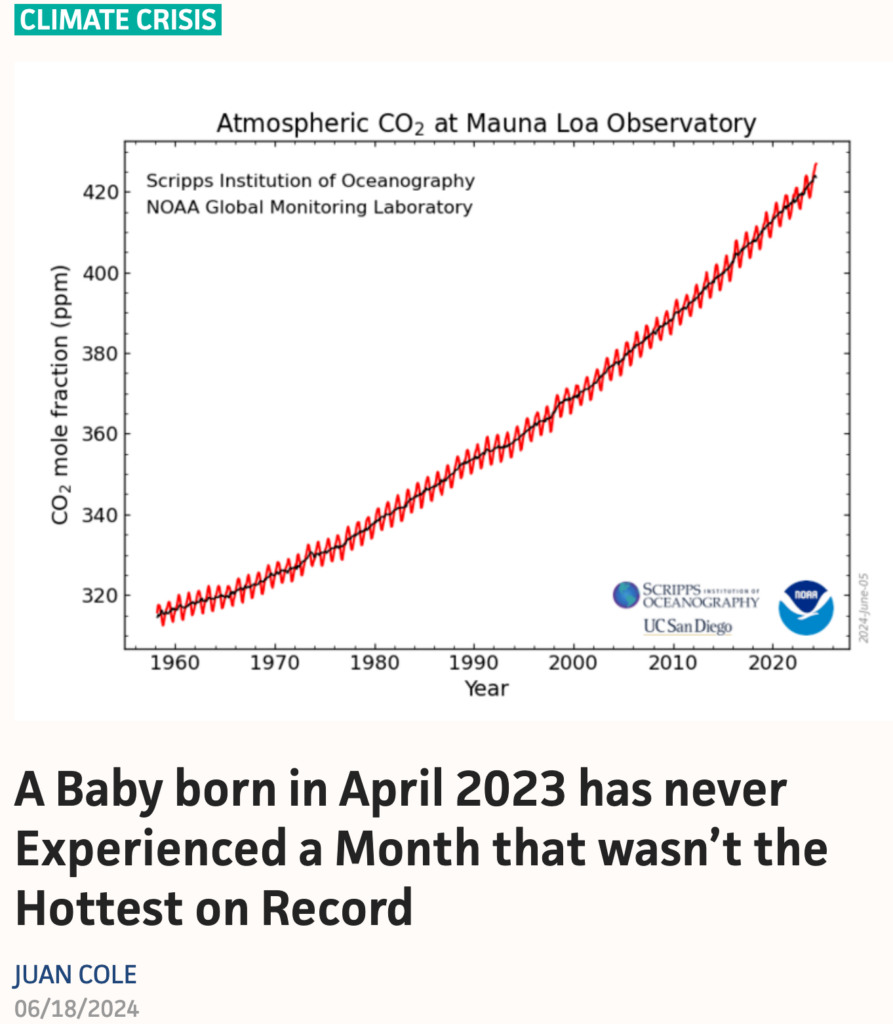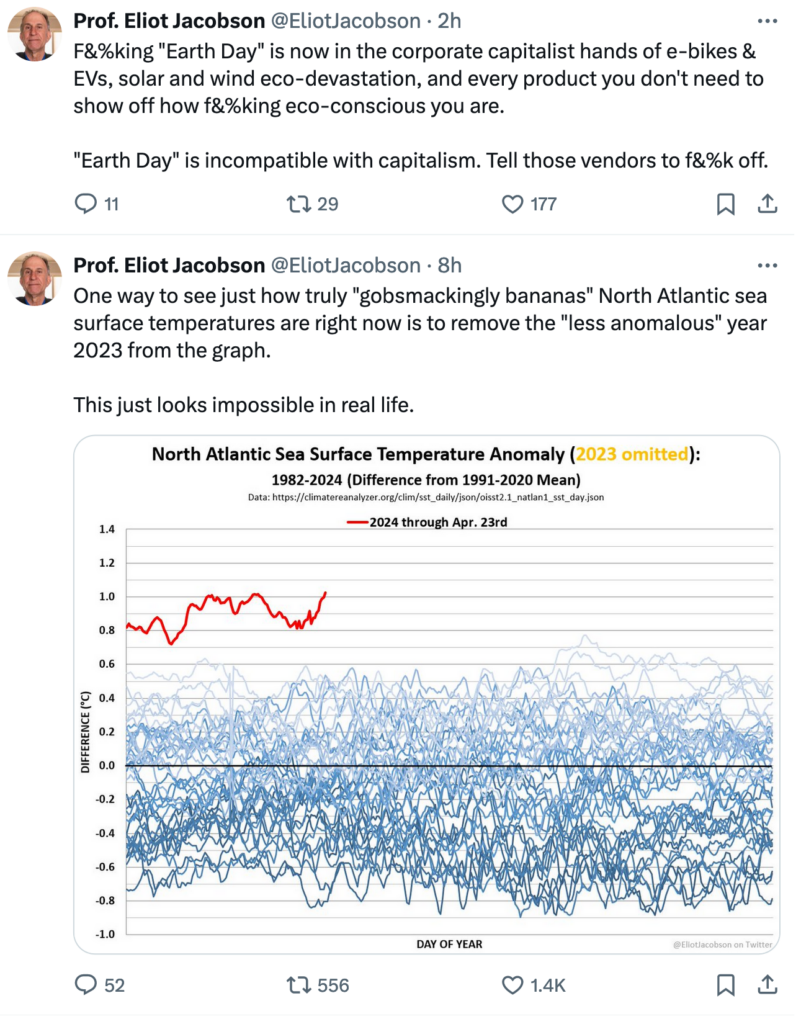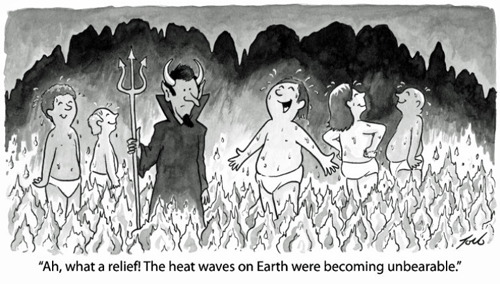Climate chaos is a catastrophe but also a teacher, and its first lesson is that everything is connected, which is both the beautiful dream of mutuality and the nightmare of runaway consequences.
-Rebecca Solnit
Early life cold and heat exposure impacts white matter development in children by Laura Granés, Esmée Essers, Joan Ballester, Sami Petricola, Henning Tiemeier, Carmen Iñiguez, Carles Soriano-Mas and Mònica Guxens, June 12, 2024, Nature Climate Change (2024)
Abstract
Prenatal life and childhood represent periods that are vulnerable to environmental exposures. Both cold and heat may have negative impacts on children’s mental health and cognition, but the underlying neural mechanisms are unknown. Here, by a magnetic resonance imaging assessment of 2,681 children from the Netherlands Generation R birth cohort, we show that heat exposure during infancy and toddlerhood as well as cold exposure during pregnancy and infancy are associated with higher mean diffusivity at preadolescence, indicative of reduced myelination and maturation of white matter microstructure. No associations for fractional anisotropy were observed. Children living in poorer neighbourhoods were more vulnerable to cold and heat exposure. Our findings suggest that cold and heat exposure in periods of rapid brain development may have lasting impacts on children’s white matter microstructure, a risk that must be considered in the context of ongoing climate change.
Climate change linked to brain damage in children — and poor kids are at greater risk, A new study found white matter size is altered by temperature fluctuations — a growing problem in our heating world by Matthew Rozsa, June 18, 2024, Salon
Perhaps the cruelest aspect of climate change is that it disproportionately impacts those least responsible for planet-cooking emissions, especially the poorest among us. Among many other things, experts predict that global heating will expose 70% of the working population to health risks and could ultimately kill roughly 1 billion people, most of them poor. But it’s not just the environment that will be impacted, but the very bodies of people.
A new study from the journal Nature Climate Change reveals a new way that climate change disproportionately impacts impoverished individuals: It alters their brains before they are even born.
“These impacts might worsen in the ongoing climate change emergency.”
It all comes down to the delicate relationship between external temperatures and the healthy development of a fetus.
Researchers from the Netherlands, the United States and Spain monitored 2,681 children over a period of more than a dozen years from a group of patients known as “the Netherlands Generation R birth cohort.” The Netherlands Generation R birth cohort (which initially included 9,896 pregnant women; many dropped from the study over the years) existed to monitor whether prenatal exposure to extreme heat and cold impacts neurological development.
By examining the patients with magnetic resonance imaging (MRIs) over the years, they learned that infants and toddlers exposed to heat and cold during pregnancy and their early years are more likely during preadolescence to have structural problems with the myelin and white matter in their brain. Additionally, their brains will have reduced mean diffusivity (MD), or the ease with which water molecules move in brain tissue.
Disproportionately, the children who suffer in this way are from low-income backgrounds.
“Children living in poorer neighborhoods were more vulnerable to cold and heat exposure,” the authors write. “Our findings suggest that cold and heat exposure in periods of rapid brain development may have lasting impacts on children’s white matter microstructure, a risk that must be considered in the context of ongoing climate change.”
More than half of the participants were from the Netherlands, with 10 percent hailing from Suriname or the Dutch Antilles and the rest identifying from nations as diverse as Turkey, Morocco and other “non-Western countries.” After most than three-quarters of the participants dropped out prior to their children aging between nine and 12 years (when they were studied using the MRI), the majority of those who remained were from “parents with a high level of education, Dutch, with a household income exceeding 2,200 euros per month, and without previous children.” The authors acknowledge that this demographic homogeneity may somewhat skew the results.
Even so, those results are bracing.
“We found an association between cold and heat exposure during pregnancy, infancy and toddlerhood and global MD in children aged 9–12 years,” the authors write. “These impacts might worsen in the ongoing climate change emergency, considering the predicted rise in global temperatures and potential increase in extreme cold events.”
They hypothesize this means that children who suffered exposure to extreme heat or cold during their prenatal stage or early infancy will not develop a healthy white matter, or the part of the brain that is vital for intellectual activities, balance and allowing various regions of the body to connect and receive signals.
After noting there was no association between cold and heat exposure in early life and global fractional anisotropy, a measure of connectivity in the brain, at 9 to 12 years, the authors said that children living in low [socioeconomic status] neighbourhoods seem to be more vulnerable to cold and heat exposure.”
“Further research is needed to elucidate cold and heat impacts on children’s brain development, especially at young ages.”
The new study is particularly significant because it is the first one to examine the physical structures of the brain in relationship to temperatures. Previous research has examined how children’s behavior changes based on temperature, but none had directly attributed those behavioral observations to the physical structures in the brain.
“As children with psychopathological symptoms and worse cognitive performance appear to have a suboptimal brain structural connectivity, defined by a poorer white matter microstructure, we hypothesized that cold and hot temperatures may have negative impacts on cerebral white matter microstructure,” the authors write. “Since white matter growth is particularly rapid in infants and toddlers, we also hypothesized that there might be specific periods of increased vulnerability to cold and heat exposure in these developmental periods.” Their new research has born out those hypotheses.
This is not the only study to show that climate change harms individual health. For example, there is increasing evidence that climate change reduces male fertility because sperm rely on lower ambient temperatures to properly develop. As temperatures go up, humans’ literally overheating testicles seem to be taxed beyond their healthy capacity.
“High scrotal temperatures have been associated with decreased sperm count and motility [ability to move], so increases in ambient temperature (e.g. through global warming) may decrease semen quality,” Dr. Shanna Swan, an environmental and reproductive epidemiologist at the Icahn School of Medicine at Mount Sinai, told Salon in March “Also increased temperatures, particularly in regions with extreme heat, can lead to heat stress, which can negatively affect sperm production and quality. In addition, consequences of global warming, such as food insecurity, natural disasters, and economic instability, can contribute to chronic stress which negatively affects semen quality, reproductive hormones and fertility.”
Swan added, “Separating the causal from the correlative is extremely difficult, as you know!”
Because it is indeed difficult to separate the casual from the correlative, even the authors of the new Nature Climate Change agree that further research is needed to prove those links are more than correlation. Importantly, we need to develop ways of mitigating this accelerating crisis.
A Baby born in April 2023 has never Experienced a Month that wasn’t the Hottest on Record by Juan Cole, June 28, 2024, Informed Comment

Ann Arbor (Informed Comment) – When a baby born on April 1, 2023 reached 14 months and became a toddler this month, it had never lived through a month that wasn’t the hottest on record.
The National Atmospheric and Oceanic Agency has announced that May 2024 was the hottest May on record. But even more worrisome, it was the 14th consecutive hottest month on record. …
While the average of earth temperatures was higher in May than ever before recorded, some places got hit worse than others. India and Pakistan saw unbearable heat waves. New Delhi, India’s capital, may have hit 49 degrees C. (122F.), and a glitch in the records caused a panic when it was misread as 52° C. (125.6° F.). Still, 48°C or 49°C was plenty hot enough to cause heat stroke and kill off dozens of people. Mexico likewise had a massive heat wave that killed some people. And Africa was deadly hot, with hot waters off Tanzania contributing to a typhoon that caused flash floods. In fact there were 5 named typhoons, an above-average number. And arctic sea ice was low, though not the lowest it has been. …
@chrislhayes:
Donald Trump just solicited a billion dollar bribe to allow the oil companies to cook the planet beyond recognition. (Thanks to SCOTUS it’s not legally bribe, but in any common sense understanding of the term, it’s exactly and obviously that

Refer also to:

![]() Every day for decades already, I grieve the loss of the climate I was born into and grew up with. I loved it. Now I find human pollution climate chaos and the heat and cold extremes unbearable; springs and summers are especially despicable and the main reason I chose not to have kids (the other is because humans, notably authorities, are not to be trusted around kids, they rape and torture kids too often and worse, human created religious-legal-judicial-policing enterprises give abusers/rapists protected access to kids and help them get away with their life destroying crimes). The deadly suffering humans are selfishly causing their own kids and other species is unforgivable while gov’ts enabled by greedy stupid voters continue to cater more and more to the rich getting richer and more profit, subsidies and deregulation for polluters.
Every day for decades already, I grieve the loss of the climate I was born into and grew up with. I loved it. Now I find human pollution climate chaos and the heat and cold extremes unbearable; springs and summers are especially despicable and the main reason I chose not to have kids (the other is because humans, notably authorities, are not to be trusted around kids, they rape and torture kids too often and worse, human created religious-legal-judicial-policing enterprises give abusers/rapists protected access to kids and help them get away with their life destroying crimes). The deadly suffering humans are selfishly causing their own kids and other species is unforgivable while gov’ts enabled by greedy stupid voters continue to cater more and more to the rich getting richer and more profit, subsidies and deregulation for polluters.![]()



